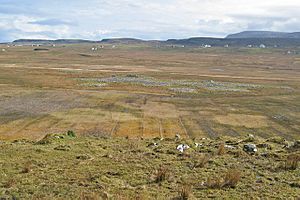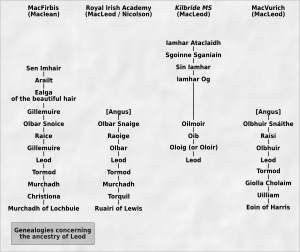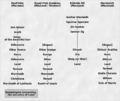Páll Bálkason facts for kids
Quick facts for kids
Páll, son of Bálki
|
|
|---|---|
| Died | 1231 |
| Opponent(s) | Gofraid Donn |
| Children | 1 son |
| Parent(s) | Bálki |
| Relatives | Foster father of Leod |
Páll, son of Bálki, also known as Paal Baalkeson, was an important lord in the Hebrides during the 1200s. He was a strong ally of Olaf the Black, who was the king of Mann and the Isles. Páll was remembered for a long time in old Gaelic stories. He is also traditionally seen as the ancestor of some families from the Hebrides. Páll held the title of "sheriff" on the island of Skye. Interestingly, another person named Páll, son of Bálki held this same job before him, and this earlier Páll might have been an ancestor. This older sheriff was a close friend of Godred II, who was also a King of Mann and the Isles.
Contents
Páll's Life and Times
Much of what we know about Páll comes from old writings like the mediaeval Chronicle of Mann and later stories from the MacLeod family. In the Chronicle of Mann, he is called Paul filius Boke and is described as a vicecomes of Skye. This title is usually translated as "sheriff" in English. It seems Páll was the official representative of the kings of Man on Skye. Later Gaelic stories sometimes call Páll a "hermit", which some historians think might actually refer to his important Norse title.
An Earlier Páll
The job of "sheriff" on Skye was held by another Páll, son of Bálki even before our Páll. This earlier Páll was likely an ancestor. He was known to be a close friend of Godred II of Mann and the Isles. A historian named W.C. Mackenzie shared a story about how Somerled wanted to become king of the Hebrides. Somerled even showed his own son, Dugald, around the islands and declared him king. He asked local leaders to support Dugald.
However, most of the leaders refused to help Somerled. This included the earlier Páll, son of Bálki. When he refused to promise his loyalty to Dugald, Páll fled to the Isle of Man. There, he warned King Godred II about Somerled's plans. Godred II quickly sent his fleet to the Hebrides to stop the rebellion. But Somerled was ready for him, and the two fleets met in battle. They fought all night. By morning, Godred II and Somerled agreed to a truce. They decided to divide the Hebrides between them. Somerled kept the islands south of Ardnamurchan, and Godred II kept those to the north. This agreement happened around the year 1156. It meant that the southern islands permanently left the control of the Kings of Mann.
The Island of Saint Columba

The Chronicle of Mann mentions an "island of Saint Columba" where Páll was involved in a fight. People have wondered which island this was. Some thought it might be Iona, which is called Ì Chaluim Chille in Scottish Gaelic. However, other islands on or near Skye have also been suggested.
One idea was the "Island of St. Colm" near Portree at Skeabost. Another suggestion is the "Island of St Columba" in the middle of the river Snizort. This island was once the site of a mediaeval cathedral. It is also the traditional burial place for the MacNeacails. A historian named Sellar thought a more likely place was Eilean Chaluim Chille, at Kilmuir, Skye. This island was originally in the middle of Loch Chaluim Chille. The loch was drained in the 1700s. Sellar believed this location fit the description in the Chronicle of Mann perfectly. He also noted that local stories linked this island to a man now believed to be Páll.
Páll's Lasting Influence
Páll has been remembered in Gaelic traditions for a very long time. In the early 1900s, a story was still told near Kilmuir about a man called Fear Caisteal Eilean Chaluim Chille ("the man of the castle of Eilean Chaluim Chille"). This man is thought to be the historical Páll.
The Bannatyne manuscript says that Paal Baccas had a son. From this son came a family that owned the island of Berneray and other lands on Harris, under the MacLeods. This family was once powerful but later became very small. The manuscript calls this family Clan Vic Phaich. They were proud of being descendants of Paal Baccas. Today, this Berneray family has the surname MacKillop. But in Scottish Gaelic, they are known as MacPhàic. Some historians believe their Gaelic name likely refers to Bálki, Páll's father, or perhaps to a son of Páll also named Bálki.

There has been some discussion among historians about whether the MacLeods are directly related through their father's side to Páll's father. One idea was that Leod, who founded Clan MacLeod, was the grandson of Bálki. This might explain why MacLeod traditions say that Paal Baccas left his lands to Leod, instead of his own son. However, this idea has been debated by other historians. The current understanding is that Leod was likely not a direct male-line descendant of Páll's father.
Images for kids


